
The Monosoupape, was a rotary engine design first introduced in 1913 by Gnome Engine Company. It used a clever arrangement of internal transfer ports and a single pushrod-operated exhaust valve to replace the many moving parts found on more conventional rotary engines, and made the Monosoupape engines some of the most reliable of the era. British aircraft designer Thomas Sopwith described the Monosoupape as "one of the greatest single advances in aviation".

The Continental C90 and O-200 are a family of air-cooled, horizontally opposed, four-cylinder, direct-drive aircraft engines of 201 in3 displacement, producing between 90 and 100 horsepower.
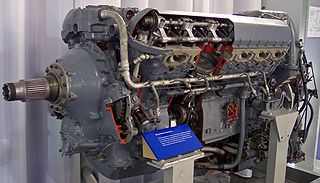
The Rolls-Royce Griffon is a British 37-litre capacity, 60-degree V-12, liquid-cooled aero engine designed and built by Rolls-Royce Limited. In keeping with company convention, the Griffon was named after a bird of prey, in this case the griffon vulture.

The Continental O-170 engine is the collective military designation for a family of small aircraft engines, known under the company designation of A50, A65, A75 and A80. The line was designed and built by Continental Motors commencing in the 1940s. It was employed as the powerplant for civil and military light aircraft.

The Lycoming O-235 is a family of four-cylinder, air-cooled, horizontally opposed, piston aircraft engines that produce 100 to 135 hp, derived from the earlier O-233 engine.

The Rolls-Royce Condor aircraft piston engine is a larger version of the Rolls-Royce Eagle developing up to 675 horsepower. The engine first ran in 1918 and a total of 327 engines were recorded as being built.

The Armstrong Siddeley Cheetah is a seven-cylinder British air-cooled aircraft radial engine of 834 cu in capacity introduced in 1935 and produced until 1948. Early variants of the Cheetah were initially known as the Lynx Major.
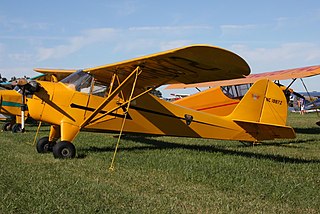
The Aeronca Model K Scout is an American light airplane first marketed in 1937, and was the true successor to the popular C-2/C-3 line.

The Aeronca L was a 1930s American cabin monoplane designed and built, in small numbers, by Aeronca Aircraft. It differed significantly from other Aeronca planes by the use of radial engines, streamlining, and a cantilever low wing.
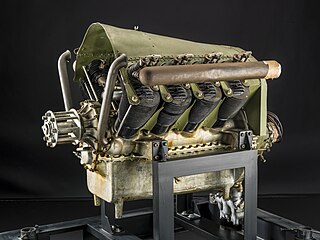
The RAF 1 is a British air-cooled, V-8 engine developed for aircraft use during World War I. Based on a French design, it was developed at the Royal Aircraft Factory, and built by six different British companies including Daimler, Rolls-Royce and Wolseley Motors Limited.
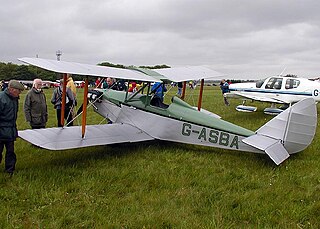
The Currie Wot was a 1930s British single-seat aerobatic biplane aircraft. Plans were sold for home building of the aircraft.
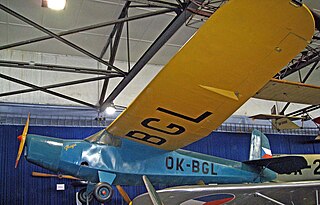
The Praga E.114 was a single-engine sport airplane, designed and manufactured by the Czechoslovakian company ČKD-Praga. Due to its light weight it was also called Air Baby.

The Bristol Cherub is a British two-cylinder, air-cooled, aircraft engine designed and built by the Bristol Aeroplane Company. Introduced in 1923 it was a popular engine for ultralight and small aircraft in the 1930s.

The Sunbeam Matabele was a British 12-cylinder aero engine that was first flown in 1918. The Matabele was the last iteration of one of Sunbeam's most successful aero engines, the Cossack.
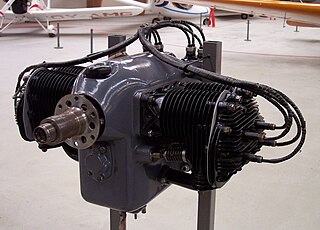
The Continental A40 engine is a carbureted four-cylinder, horizontally opposed, air-cooled aircraft engine that was developed especially for use in light aircraft by Continental Motors. It was produced between 1931 and 1941.

The Armstrong Siddeley Ounce was a small two-cylinder aero engine developed by Armstrong Siddeley in 1920. The engine was originally conceived as a test piece but ran very well and was put into production for early ultralight aircraft and use in target drones. The Ounce used two cylinders from the preceding Jaguar I radial engine.

The Lycoming O-145 is a family of small, low-horsepower, four-cylinder, air-cooled engines. It was Lycoming Engines' first horizontally opposed aircraft engine and was produced from 1938 until the late 1940s. The family includes the reduction-geared GO-145. The O-145 received its Approved Type Certificate on 13 Jun 1938.
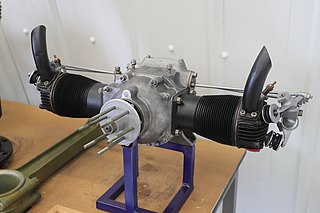
The ABC Scorpion is a 30 hp (22 kW) two-cylinder aero engine designed by British engineer Granville Bradshaw for use in light aircraft. The engine was built by ABC Motors Limited and first ran in 1921.

The Sunbeam Cossack was a British 12-cylinder aero engine that was first run in 1916. The Cossack spawned a family of engines from Sunbeam.

The Aeronca E-107 was one of the first low-cost reliable engines of the post-World War I era.




















